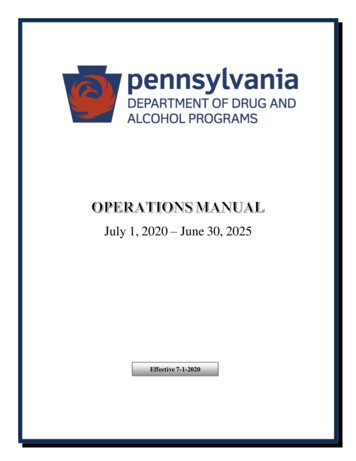
Transcription
2020-2025STATE of MISSISSIPPIStrategic Plan for Alzheimer’s Diseaseand Related Dementias2020 – 2025
TABLE OF CONTENTS2Introduction6History7ResearchGoal 1: Support research in Alzheimer’s disease and related dementiasto accelerate scientific discoveries. . 9-1112 Community AwarenessGoal 2: Increase public awareness of Alzheimer’s diseaseand other dementias. . 13-1415 Coordinated CareGoal 3: Enhance the delivery of coordinated, competent, and comprehensivedementia care to improve the quality of life for persons with Alzheimer’sdisease and dementia as well as their families/caregivers. 16-1718 Caregiver SupportGoal 4: Enhance the availability of and access to support services forcaregivers and family members of individuals withAlzheimer’s disease and dementia. . 19-2021 Brain HealthGoal 5: Implement initiatives that improve brain health and promote healthyaging in Mississippians. 22-2324 Next Steps25 State Plan Group Members & Contributors
INTRODUCTIONThe Mississippi State Strategic Plan for Alzheimer’s Disease and Other Dementias (State Plan) is acollaborative project led by The MIND Center at the University of Mississippi Medical Center in partnershipwith the Department of Mental Health, the Alzheimer’s Association Mississippi Chapter, and Alzheimer’sMississippi, along with stakeholders from across the state including the Department of Human Services,Division of Aging; and the Department of Health, Office of Preventive Services. More than 40 representativeshave participated in the State Plan development and implementation from family caregivers to health careprofessionals and affiliates from organizations and occupations across the statesuch as long term care, hospice, home health, clinical research, social work,nursing, public safety, and pharmacy.The State Plan was modeled after the National Alzheimer’s Project Act whichwas signed into law on January 4, 2011 and was developed in recognitionof the enormous social, emotional, and economic impact of Alzheimer’sdisease (AD) and other dementias and the need to insure we are prepared to meetthe needs of individuals and families impacted by these diseases in Mississippi.State Alzheimer’s Disease Plans create an infrastructure and accountabilitynecessary to build dementia-capable programs, services and systems for thegrowing number of people affected by AD and other dementias.The State Plan outlines a comprehensive and inclusive state strategy to prepare for the current andimpending issues facing the state by quantifying the number of individuals affected by Alzheimer’sdisease and dementia and determining the levels of services available and needed at all stages of thedisease for the individual affected as well as their caregivers. This approach helps to prepare Mississippito address the Alzheimer’s epidemic with an integrated and cost-effective approach.The State Plan represents a major focus on bringing together advocates, caregivers, andprofessionals from health care, education, and social services to identify ways to more effectivelyaddress current and future needs related to Alzheimer’s disease. Individuals with diverse backgroundsand areas of expertise converged to invest their time, energy, and talents on a voluntary basis in thedevelopment and implementation of the State Plan.The State Plan outlines five goals, each with accompanying objectives and strategic priorities witha focus on (1) Research, (2) Community Awareness, (3) Coordinated Care, (4) Caregiver Support,and (5) Brain Health. Broadly speaking, the State Plan outlines actions to: increase awareness of andunderstanding about Alzheimer’s disease; bring focused attention to the quality of care and services forpersons with Alzheimer’s disease and dementia while improving the capacity of Mississippi’s workforceto respond to the needs of persons with these diseases; strengthen support for caregivers; increaseMississippi’s capacity for Alzheimer’s and dementia-related research and data collection; and elevatethe level of understanding of Mississippians regarding ways to promote or improve brain health.—2—
Overview of Alzheimer’s diseaseDementia is an umbrella term for diseases and conditions characterized by a decline in cognitive skillsthat affect a person’s activities of daily living. Dementia is caused by damage to nerve cells in the braincalled neurons which causes those neurons to function improperly and eventually die. This in turn canlead to changes in memory and behavior and problems with reasoning and judgment.Clinical guidelines for the diagnosis of Alzheimer’s disease have been formulated by theNational Institutes of Health - Alzheimer’s Disease and Related Disorders Association; the AmericanPsychiatric Association in the Diagnostic and Statistical Manual of Mental Disorders, Fifth Edition(DSM5); and the Consortium to Establish a Registry in Alzheimer’s Disease. In 2011, the NationalInstitute on Aging and the Alzheimer’s Association released new research and clinical diagnosticcriteria for Alzheimer’s disease. The criteria for the diagnosis of Alzheimer’s disease require thefinding of a slowly progressive memory loss of insidious onset in a fully conscious patient.¹The Diagnostic and Statistical Manual of Mental Disorders (DSM) is often utilized by physicians todefine dementia.In 2013 the American Psychiatric Association released the fifth edition of theDSM-5 which incorporates dementia into the diagnostic categories of major and mild neurocognitivedisorders. Major neurocognitive disorders are generally characterized by cognitive decline that interfereswith everyday activities and that may require assistance. Mild neurocognitive disorders are evidencedby modest cognitive decline that does not interfere with everyday activities.²There are multiple types of dementia including, but not limited to, AD, vascular dementia, LewyBody dementia, frontotemporal, mixed dementia and Parkinson’s disease.Each type of dementiais associated with distinct symptom patterns and brain abnormalities. Some conditions result inbehaviors that mimic dementia, but are in fact reversible if treated. These reversible causes mayinclude infections and immune disorders, metabolic problems and endocrine abnormalities, nutritionaldeficiencies, medication side effects, subdural hematomas, poisoning, brain tumors, anoxia, andnormal-pressure hydrocephalus.³Alzheimer’s disease is the most common form of dementia and accounts for an estimated 60% to 80%of cases. Eventually the person with Alzheimer’s disease will require complete care as their ability tocarry out basic bodily functions such as walking and swallowing will be impaired. Alzheimer’s diseaseis ultimately fatal.4—3—
Alzheimer’s Disease and Dementia PrevalenceThe impact of Alzheimer’s disease is far-reaching. An estimated 5.8 million Americans haveAlzheimer’s dementia in 2019, including 55,000 in Mississippi. That’s an increase of 1,000 inMississippi over 2018. It is estimated that the number of people aged 65 and older living withAlzheimer’s disease in Mississippi will increase by 18.2% by 2025 to 65,000.5In Mississippi, the incidence of the disease is equally daunting. It is estimated that in 2014, 51,000Mississippians aged 65 and older are living with Alzheimer’s disease. This number does notinclude the many thousands more with younger-onset Alzheimer’s disease or those with relateddementias. Mississippi, like the rest of the country, is in the midst of an unprecedented growth in the olderpopulation. Between 2014 and 2025, the number of persons aged 65 and over with Alzheimer’s disease inMississippi is expected to grow by 27% (from 51,000 people to 65,000 people).5The impact of Alzheimer’s disease is experienced perhaps most intensely by family caregivers.Nationally, more than 16 million Americans provide unpaid care for people with Alzheimer’s or otherdementia. These caregivers provided an estimated 18.5 billion hours valued at nearly 234 billion.In Mississippi, 207,000 caregivers provided a total of 236 million hours of unpaid care, valued ata total of 3 billion. Caregivers of people living with Alzheimer’s have a 142 million higher healthcost than those not caring for someone with Alzheimer’s.5Sadly, deaths due to Alzheimer’s have increased an alarming 145 percent since 2000, while deaths formost other major diseases have decreased. Alzheimer’s disease is the sixth leading cause of death inthe U.S. It kills more than breast cancer and prostate cancer combined. One in three seniors dies withAlzheimer’s or another dementia. In 2017, there were 1,626 deaths from Alzheimer’s in Mississippi. Thisrepresents an increase of 267% in Alzheimer’s deaths in Mississippi since 2000.5The prevalence of Alzheimer’s disease has a significant impact on the health care system and onhealth care costs and the costs are unsustainable. For the third consecutive year in 2018, the costof caring for individuals with Alzheimer’s is surpassing a quarter of a trillion dollars. By 2050, thesecosts could rise as high as 1.1 trillion. It is expected that the Medicaid costs of caring for peoplewith Alzheimer’s in Mississippi will be 587 in 2019 – and is expected to grow by 22.9 percentover the next six years (by 2025).5The growth in the incidence and prevalence of Alzheimer’s disease has important implicationsfor health care providers. The expansion of the older population nationally and in Mississippi hascreated an increased demand for health care services, including importantly, the demand for long—4—
term care services. Nursing homes, assisted living facilities, home health agencies, personal assistanceservices agencies, adult day services agencies and other providers require staff to support a growingpopulation with long term care service needs.Beyond that, all health care providers must rely increasingly on the availability of a workforce that hasbeen trained to support the specific care needs of individuals with Alzheimer’s disease and relateddisorders. These statistics highlight the importance of the State Plan which is paramount to addressingthe many challenges facing people with Alzheimer’s disease and their families in Mississippi.References¹ National Institute on Aging. “Alzheimer’s Disease Diagnostic Guidelines.” Dementia Resources for HealthProfessionals. Nov. 21, gnostic-guidelines² American Psychiatric Association. “Diagnostic and Statistical Manual of Mental Disorders.” May 18, ³ Mayo Clinic. “Dementia Symptoms and Causes.” Patient Care & Health Information. April 19, ia/symptoms-causes/syc-20352013Alzheimer’s Association. “What is Alzheimer’s Disease?” Alzheimer’s and dementia. Dec. 5, imers4Alzheimer’s Association. 2019 Alzheimer’s Disease Facts and Figures. Mar. 5, 5—5—
HISTORYIn 1998, the Alzheimer’s Association Mississippi Chapter aggressively lobbied for and secured passage oflegislation which for the first time, provided a means to address the critical issues related to Alzheimer’sdisease and dementia as a matter of state public policy. The genesis of the 1998 effort began in 1996 whenAlzheimer’s Association volunteers first appeared before the Public Health Committees of the MississippiHouse of Representatives and Senate for support. In 1997, Senate Committee Chairman, Jim Bean, andHouse Committee Chairman, Bobby Moody, requested that the Association provide specific legislativerecommendations.Those specific recommendations were made in 1998. The Department of Mental Health, underthe leadership of Director Randy Hendrix, PhD, supported legislation [codified at Mississippi Code of 1972,§ 41-4-7 (ee)], which required that the Department of Mental Health develop an Alzheimer’s State Plan fortwo key reasons:1) To provide education and training to service providers, family caregivers, and others who dealwith Alzheimer’s disease and other dementias;2) To develop adult day care, family respite care, and counseling programs to assist familieswho maintain persons with Alzheimer’s disease and other dementias in the home setting.Initially the State Plan served as an operational guide that outlined the activities and priorities for theDepartment of Mental Health Division of Alzheimer’s Disease and Related Dementias. Effort to expandthe State Plan grew with the passage of the National Alzheimer’sProject Act of 2011 and subsequent development of a National Plan toAddress Alzheimer’s Disease. In 2013, the Division of Alzheimer’sormalized strategic partnerships with relevant stakeholders in an effortto share resources related to Alzheimer’s disease and other dementiasand work began to create the formalized State Plan that exists today.Following months of extensive collaboration amongst more than 40contributors and stakeholders, the 2015 - 2020 State of MississippiStrategic Plan for Alzheimer’s Disease and Related Dementias wasreleased on December 5, 2014 at the 3rd Annual MississippiAlzheimer’s State Planning Summit. Implementation of the goals,objectives and strategic priorities outlined in the State Plan began2015-2020STATE of MISSISSIPPIon July 1, 2015 and continues today, with significant progressStrategic Plan for Alzheimer’s Diseaseand Related Dementiasresulting in the focus areas including research, community awareness,2015 – 2020coordinated care, caregiver support, and brain health. In 2018,the Department of Mental Health entered into a Memorandum of Understanding with The MIND Center at theUniversity of Mississippi Medical Center to assume responsibility for the management of the State Plan tocontinue to advance its mi
Strategic Plan for Alzheimer’s Disease 2020-2025 and Related Dementias . term care services. Nursing homes, assisted living facilities, home health agencies, personal assistance services agencies, adult day services agencies and other providers require staff to support a growing population with long term care service needs. Beyond that, all health care providers must rely increasingly on .











